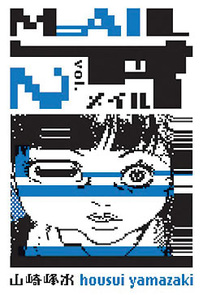Review
by Carlo Santos,GN 2
| Synopsis: |  |
||
Reiji Akiba looks like your typical eccentric detective, but with one difference—he investigates the dead! Armed with a sanctified gun, Akiba uses sacred bullets to send troubled spirits to their final rest. His latest cases will have him looking into a haunted doll, a possessed baby, an elevator stuck between floors, a mysterious cottage, an ill-fated school graduation, and a creepy painting. Akiba's clients may not always believe what he has to say, but by the time he's done with his work ... they will. |
|||
| Review: | |||
Since the earliest days of popular fiction, the short-story horror genre has drawn in readers with grim tales of unnatural phenomena. Some border on the wild and fantastical, filled with psychics and monsters; some are flavored with interdisciplinary approaches that may include both science and faith; others take the down-to-earth route and place ordinary things in the realm of the bizarre. Mail falls firmly into that last category, with sketches of modern life taking a turn for the macabre. This volume sees the series settling into a steady groove as Akiba continues his investigations; grotesque imagery and suspenseful storytelling guarantee plenty of chills this time around. Just one problem: ever get the feeling that you've read all this stuff somewhere before? That's the biggest weakness of Mail, right there. As an episodic short story series, it's already in danger of being hit-or-miss with each chapter, and the urban-legend elements make it even more overtly familiar. Too familiar, in fact. Just about everything that's been used in horror tales past and present comes up in Yamazaki's stories: a haunted doll (in Victorian style, of course), a possessed painting, a creepy little house. Even the glitchy GPS system that appears in one chapter is basically an update of those wayward compasses from nautical ghost stories. The predictable story structure also leads to tedium: in the end, Akiba always gets his ghost, spouting a catchphrase as he administers his holy bullet. The first time, it's pretty cool. But as chapter after chapter ends the exact same way ... well, you almost want him to miss for once, just to see what happens. The only thing that changes is the victim and the method of haunting. Within that strict framework, however, Housui Yamazaki has refined his craft to a high level. No matter what the situation, he can always dish out a good scare with uneasy moods and suspenseful pacing. The characters in each story all tend to resemble each other—wide-eyed common folk who know something's wrong, but won't admit to it—but this grim psychology is what drives each chapter forward. Add to that a perfect sense of beat and timing—panel to panel, page to page, until a horrific image is revealed—and it's easy to see how this series can still generate chills despite its use of familiar ideas. Like the best stories of its kind, it's not trying to go for blood and gore on every page; instead, it leads you by a soft, comforting hand ... one that grows colder and colder by the minute, until that awful moment of terror strikes. Visual layouts are the key to this manifestation of fear. Yamazaki has a natural knack for the full-page and two-page spread, using strong perspective and shocking images to deliver a powerful effect. Even if it's just a straight-ahead view, there's always something frightening to behold: your best friends' deformed heads, or ghostly kids walking through a field. Efficiency of line is another trademark of the artwork; the style may not be incredibly detailed, but it's still very confident, with precise curves outlining the realistically-proportioned characters, and simple hatch lines providing the shading. Blacks and solid grays help to add contrast, and at the same time establish the dour mood that hangs over the work. Backgrounds are also essential to each story's setting, and Yamazaki clearly has the chops to handle these: countrysides, suburbs, apartment interiors, and the most unique challenge, a claustrophobia-inducing elevator. With slick storytelling and efficient artwork already in this series' favor, a top-notch translation is simply icing on the cake: there's nothing to complain about in the dialogue, which reads like the most natural thing in the world. Like the actual stories, the script is down-to-earth, getting the point across with a minimum of fuss. Text within the artwork is also translated effectively: handwritten letters and diaries actually look like they've been in English the whole time, a feat that few manga translations have ever accomplished. Sound effects are the only problem spot—all the Japanese characters have been left intact, but translation is provided in the form of a back-of-the-book glossary, which is probably not the most efficient way to do it. (Do YOU feel like flipping back for every single BAN and KACHA? Didn't think so.) Readers will enjoy the first-rate print job, though, with the distinctive cardboard-style cover and flawlessly reproduced art. There are a lot of good things going for Mail, with its well-crafted, suspenseful stories and striking artwork. Yet those stories rely on time-worn chestnuts of horror fiction, turning this into little more than a particularly high-class iteration of folk tales and urban legends. So take these words of warning while entering into Reiji Akiba's world of supernatural sleuthing: be ready for a fright, but also be ready for the same stuff you see in all other horror stories. Surely you've already heard from plenty of other folks about the spiritual dangers of the ordinary world. This series just happens to be really good at making you stick around for the whole spiel. |
| Grade: | |||
|
Overall : B
Story : B-
Art : A-
+ Technically accomplished art and storytelling will give you a good scare. |
|||
| discuss this in the forum (4 posts) | | |||
| Production Info: | ||
|
Full encyclopedia details about Release information about |
||